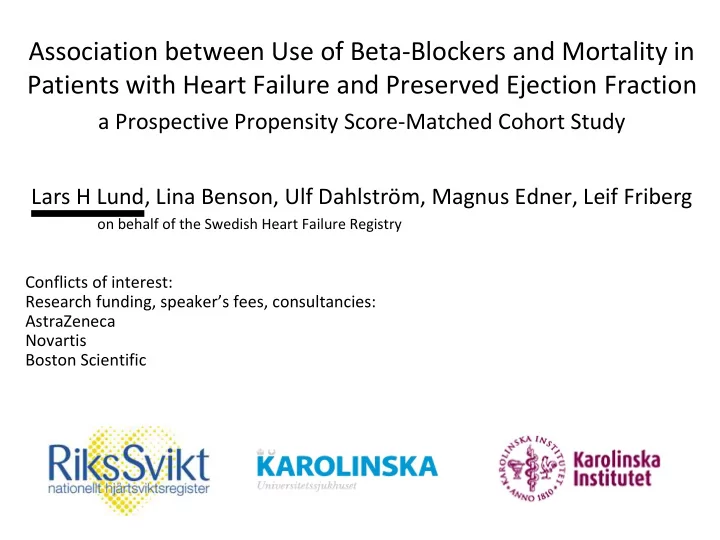

Association between Use of Beta-Blockers and Mortality in Patients with Heart Failure and Preserved Ejection Fraction a Prospective Propensity Score-Matched Cohort Study Lars H Lund, Lina Benson, Ulf Dahlström, Magnus Edner, Leif Friberg on behalf of the Swedish Heart Failure Registry Conflicts of interest: Research funding, speaker’s fees, consultancies: AstraZeneca Novartis Boston Scientific
Background Heart Failure with Preserved Ejection Fraction – HFpEF • As common and possibly as lethal as HF with reduced EF - HFrEF • Catecholamine activation • β-blockers reduce blood pressure, LVH, diastolic dysfunction • But few clinical studies and conflicting outcomes
Background Hypothesis: β-blockers are associated with Primary outcome: Reduced all-cause mortality Secondary outcome: Reduced combined all-cause mortality or HF hospitalization - in a broad un-selected HFpEF population
Methods The Swedish Heart Failure Registry • Inclusion criteria: clinician-judged HF • Exlusion criteria: opt-out
Methods Swedish HF Registry: • Demographics • Clinical history • Physical exam, lab, x-ray, echo 88,663 Registrations • Medications 2000 – 2013 Swedish Patient Registry: 67 of 75 hospitals validity / generalizability • Comorbidity 52 relevant co-variates Statistics Sweden: reliability • Education • Income • Family situation 10,905 EF unknown 77,757 45,397 EF < 40% 32,360 EF ≥ 40% 13,277 Repeat registrations Or index before 2005 / after 2012
Methods BB No: 3,297 19,083 EF ≥ 40% BB yes: 15,786 Propensity score matching 2:1 24,747 EF < 40% ”positive control” BB No: 2,748 8,244 Matched population BB Yes: 5,496
Results Baseline characteristics: Total cohort BB- No BB- Yes Variable p n=3,297 n=15,786 Age 77±12 75±12 <0.01 Gender, female 45% 47% 0.09 History of AMI 26% 37% <0.01 Blood pressure 132/72 132/74 0.32/0.01 NYHA class <0.01 I-II 64% 66% III-IV 36% 34% LVEF <0.01 40-49% 39% 51% ≥ 50% 61% 49% Creatinine clearance, mL/min 62±33 65±34 <0.01 1,622 2,100 NT-proBNP, ng/L 0.04 (620-3,948) (923-4,569) RAS-antagonist 68% 80% <0.01 Malignancy 16% 14% 0.01 Married / cohabitating 43% 46% Highest education 0.07 Compulsory 52% 50% Secondary 34% 36% University 14% 14% Overall cohort: Treated patients: younger, lower EF, higher NT-proBNP, more RAS-antagonist use
Results Baseline characteristics: Total cohort Matched cohort BB- No BB- Yes BB- No BB- Yes Variable p p n=3,297 n=15,786 n=2,748 n=5,496 0.83 Age 77±12 75±12 <0.01 78±11 78±11 0.94 Gender, female 45% 47% 0.09 46% 46% <0.01 History of AMI 26% 37% <0.01 29% 32% 0.46/0.50 Blood pressure 132/72 132/74 0.32/0.01 132/72 132/72 <0.01 NYHA class <0.01 I-II 64% 66% 62% 65% III-IV 36% 34% 38% 35% 0.60 LVEF <0.01 40-49% 39% 51% 41% 42% ≥ 50% 61% 49% 59% 58% 0.38 Creatinine clearance, mL/min 62±33 65±34 <0.01 61±33 61±32 1,622 2,100 1,920 1,842 NT-proBNP, ng/L 0.04 0.63 (620-3,948) (923-4,569) (773-4,473) (741-4,340) RAS-antagonist 68% 80% <0.01 72% 70% 0.04 Malignancy 16% 14% 0.01 15% 16% 0.36 Married / cohabitating 43% 46% 44% 43% Highest education 0.07 0.02 Compulsory 52% 50% 51% 53% Secondary 34% 36% 34% 35% University 14% 14% 14% 12% Overall cohort: Treated patients: younger, lower EF, higher Matched cohort: small differences NT-proBNP, more RAS-antagonist use
Results Propensity score for β-blocker Propensity scores Similar Different
Results β-blockers associated with reduced mortality in HFpEF 1-year survival 84% 5-year 80% survival 79% 78% 51% Un-adjusted HR: 0.73, p < 0.001 NNT=100 45% 42% 41% Matched HR: NNT=33 0.92, p = 0.021
Results β-blockers associated with reduced mortality in HFpEF 1-year survival 84% 5-year 80% survival 79% 78% 51% Un-adjusted HR: 0.73, p < 0.001 NNT=100 45% 42% 41% Matched HR: NNT=33 0.92, p = 0.021 But β-blockers not associated with reduced combined mortality / HF hospitalization in HFpEF
Results HFrEF positive control: Matched HR: 0.90, p=0.008
Conclusion Summary: • β-blockers were associated with reduced all-cause mortality in HFpEF: HR 0.92 - 8% reduction in all-cause mortality • But not combined all-cause mortality / HF hospitalization • HFrEF positive control: Similar reduction mortality lends support to HFPEF findings Implication: • Adequately powered randomized trial needed in HFpEF Future Direction: • Registry Randomized Trial
Recommend
More recommend